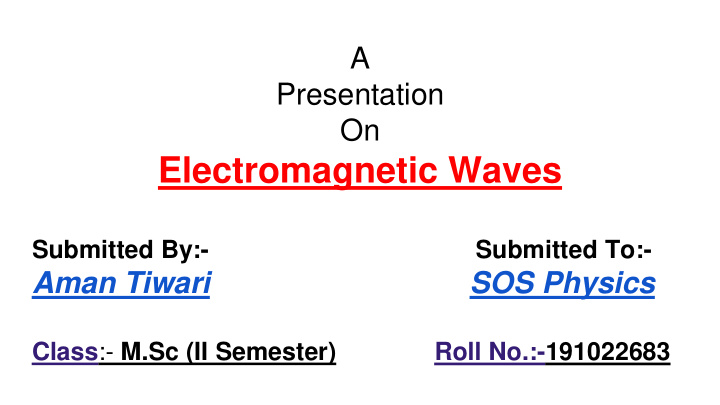



A Presentation On Electromagnetic Waves Submitted By:- Submitted To:- Aman Tiwari SOS Physics Class :- M.Sc (II Semester) Roll No.:-191022683
Overview of Electromagnetic Waves:- ❖ What are Waves? ❖ Categories of Waves. ➢ Longitudinal waves. ➢ Transverse waves. ❖ Electromagnetic Waves. ❖ Properties of Electromagnetic waves.
● What are waves..?? When we think of the word wave, we usually picture someone moving their hand BACK & FORTH to say hello or maybe we think of a curling wall of water moving in from the ocean to crash on the beach. In Physics, “ A wave is a disturbance that travels through space and matter transferring energy from one place to another.”
● Categories of waves On the basis of the direction of movement of the individual particles of the medium relative to the direction that the waves travel, the waves are categorised in :- 1. Longitudinal waves. 2. Transverse waves.
● Longitudinal Waves. A longitudinal wave is a wave in which particles of the medium move in a direction parallel to the direction that the waves move. Such as :- Sound waves.
● Transverse waves A transverse wave is a wave in which particles of the medium move in a direction perpendicular to the direction that the waves moves. Note:- The Electromagnetic Waves are Transverse waves.
● What are Electromagnetic Waves? We have ever turned in to listen to radio, spoken on headphone, turned on a light, had an x-ray taken, felt the warmth of the sun on our skin. We have experienced electromagnetic wave. The electromagnetic waves can be defined as:- “The waves that are propagated by simultaneous periodic vibrations of electric and magnetic field intensity and that include radio waves, infrared, visible light, ultraviolet, X rays and gamma rays.
● Properties of Electromagnetic waves. 1. All electromagnetic waves are transverse wave. 2. They do not require any medium to travel through. 3. They travel at the speed of 3×10 8 ms -1 in vaccum. 4. They can all be reflected or refracted. 5. They can all be emitted or absorbed by matter.
6. They all obey the wave equation. V = f x λ Where, v = speed of light (m/s) f = frequency of wave (Hz) λ = wavelength (m)
7. Their frequencies do not change as they pass from one medium to another. However, both their speed and wavelength will change. 8. They carry energy from one place to another. 9. They are all of neutral charge as well of them of them oscillates with electric and magnetic field perpendicular to each other.
Recommend
More recommend